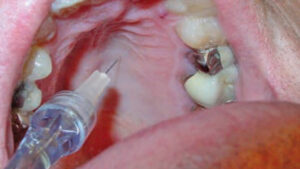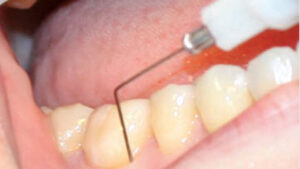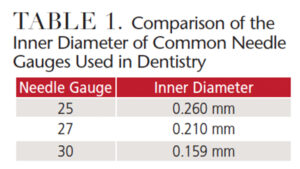
Advantages of Computer-Controlled Anesthesia
Fluid pressure and tissue type play key roles in successful pain management when utilizing this form of anesthesia delivery.
The use of computer-controlled local anesthesia delivery (CCLAD) can help simplify pain management in the dental setting. Ensuring patient comfort is integral not only to successful treatment outcomes, but also in creating a positive dental experience for patients. This, in turn, supports patient compliance and return for follow-up care.
Compared with traditional manual syringes, CCLAD devices deliver local anesthetic drugs in a slow, controlled manner. Because they help improve patient comfort during local anesthesia administration, these units can be especially helpful for individuals who fear injections, as the needle is less visible than in a manual syringe. In addition, their use results in reduced pain perception in adults and fewer pain-related disruptions among pediatric patients.1
The ability to consistently maintain slow, safe deposition rates is one benefit of CCLAD technology. These devices also offer rapid onset during administration of a periodontal ligament injection. This helps to address difficult-to-anesthetize teeth and improves the ability to administer supplemental injections when field or block anesthesia is incomplete.2,3 The administration of anesthesia with CCLAD offers ergonomic benefits for clinicians, including a reduction in muscle activity and force required to give injections; there is also less need for the static postures typically required for local anesthesia delivery.4
In a previous paper, the authors examined injection fluid dynamics and needle positioning for CCLAD devices.5 This article will focus on the implications of fluid pressure and tissue type when administering local anesthesia via computerized delivery.
FLUID PRESSURE CONSIDERATIONS
Fluid pressure is created when a plunger is depressed to create a flow of anesthetic into the tissue. Many clinicians routinely use small-diameter (30-gauge) needles during local anesthesia delivery, assuming they provide greater injection comfort than larger-diameter (27- or 25-gauge) needles (Table 1).6,7 When considering fluid dynamics, however, injection pressures with 30-gauge needles are actually higher than with 27- or 25-gauge needles. Increased injection pressure potentially results in increased pain and postoperative discomfort.8–10 A study by Tzafalia and Sixou10 noted that significantly more anesthetic was expelled in the first 15 seconds with a 27-gauge needle compared to a 30-gauge needle. Overall, they found that more than 80% of the simulated depositions resulted in bursts capable of triggering injection pain during the first few seconds.
By comparison, CCLAD systems are able to administer the anesthetic drop by drop during the initial stage of the injection, with a slow, consistent increase in injection rate over time, which eliminates pain caused by high fluid pressures. One CCLAD system also monitors and regulates real-time pressures generated at needle tips. This ensures fluid dynamic pressures are continuously measured and limited to preset values, thus minimizing fluid pressures.


tissues with moderate tissue compliance, are located in attached gingiva and palatal tissues.

TISSUE TYPE
Because the oral cavity contains a variety of tissue types, research has demonstrated that tissue-specific flow rates and optimal pressure values are needed for safe and comfortable injections.1,9 The three basic tissue classifications — type 1, type 2 and type 3 — are based on compliance (or distensibility).
Type 1 refers to low-density tissues with high tissue compliance found in the buccal mucosa and retromolar fossae (Figure 1). The optimal flow rate range is greater than 0.005 ml/second and less than 0.03 ml/second, producing pressures from 9 to 12 psi.
Type 2 includes moderate-density tissues with moderate tissue compliance found in attached gingiva and palatal tissues (Figure 2), which are less adaptive and require slower flow rates than type 1 tissues. The optimal flow rate is approximately 0.005 ml/second, which produces moderate pressures that range from 50 to 75 psi.
Type 3 encompasses high-density tissues with very low tissue compliance (i.e., minimal adaptive capacity), such as found in periodontal ligaments (Figure 3). This type requires a fixed, slow flow rate of 0.005 ml/second and produces tissue pressures ranging from 225 to 350 psi. All three tissue types, along with relevant flow rates and pressures, are summarized in Table 2.
 CONCLUSION
CONCLUSION
Patient comfort can be a significant contributor to successful treatment outcomes and also encourages compliance with follow-up appointments. In addition, strategies that support patient comfort may help reduce stress for both patients and clinicians. Implementing CCLAD technology can reduce injection pressures and pain for patients, while also improving administration ergonomics for clinicians.
KEY TAKEAWAYS
- Ensuring patient comfort is integral to successful treatment outcomes, also for creating a positive dental experience for patients.
- The ability to maintain slow, safe deposition rates is one benefit of computer-controlled local anesthesia delivery
(CCLAD). - Computer-controlled delivery also provides rapid onset during administration of a periodontal ligament injection.
- Using a CCLAD device offers ergonomic benefits for clinicians, such as reducing the muscle activity and force required to give injections.
- This technology administers the anesthetic drop by drop during the initial stage of the injection, with a slow, consistent
increase in injection rate over time, which eliminates pain caused by high fluid pressures. - Strategies that support patient comfort may help reduce stress for both patients and clinicians, while also improving treatment acceptance and compliance with follow-up visits.
REFERENCES
- Gibson RS, Allen K, Hutfless S, Beiraghi S. The Wand vs. traditional injections: a comparison of pain related behaviors. Pediatr Dent. 2000;22:458–462.
- Bassett KB, DiMarco AC, Naughton DK. Local Anesthesia for Dental Professionals. Upper Saddle River, New Jersey: Pearson Education; 2010.
- Ferrari M, Cagidiaco MC, Vichi A, Goracci C. Efficacy of the Computer-Controlled Injection System STATM, the Ligmaject, and the dental syringe for intraligamentary anesthesia in restorative patients. Inter Dent SA. 2008;11(1):4–12.
- Kaufman KR, An KN, Litchy WJ, Cooney WP 3rd, Chao EY. In vivo function of the thumb muscles. Clin Biomech. 1999;14:141–150.
- Bassett K, DiMarco A. The next generation of pain relief. Dimensions of Dental Hygiene. 2014;12(7):36–38.
- Flanagan T, Wahl MJ, Schmitt MM, Wahl JA. Size doesn’t matter: needle gauge and injection pain. Gen Dent. 2007;55:216–217.
- Diggle L, Deeks JJ, Pollard AJ. Effect of needle size on immunogenicity and reactogenicity of vaccines in infants: randomized controlled trial. BMJ. 2006;333:571–578.
- Kudo, M. Initial injection pressure for dental local anesthesia: effects on pain and anxiety. Anesthesia Progress. 2005;52:95–101.
- Hochman MN, Friedman MJ, Williams W, Hochman CB. Interstitial tissue pressure associated with dental injections. Quintessence Int. 2006;37:469–476.
- Tzafalia M, Sixou JL. Administration of anesthetics using metal syringes. an ex vivo study. Anesth Prog. 2001;58:61–65.
Featured photo courtesy DANIEL ZGOMBIC/ISTOCK/ THINKSTOCK
The authors have no commercial conflicts of interest to disclose.
From Decisions in Dentistry. December 2016;2(12):26-28.



